MENU
The Electronic Scholarly Publishing Project: Providing access to classic scientific papers and other scholarly materials, since 1993. More About: ESP | OUR CONTENT | THIS WEBSITE | WHAT'S NEW | WHAT'S HOT
Comparative Timelines
The ESP Timeline (one of the site's most popular features) has been completely updated to allow the user to select (using the timeline controls above each column) different topics for the left and right sides of the display.
Select:
New Left Column
New Left Column
Dates
Decade
New Right Column
New Right Column
 Charles Darwin's Zoology of the Voyage of the Beagle appears.
Charles Darwin's Zoology of the Voyage of the Beagle appears.
Martin Barry expressed the belief that the spermatozoon enters the egg.
1840
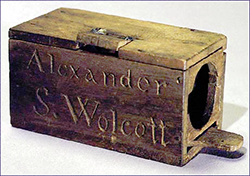 First American patent issued in photography to Alexander Wolcott for his camera.
First American patent issued in photography to Alexander Wolcott for his camera.
 The first postage stamp, called the "Penny Black" and bearing the image of Queen Victoria, is issued in England.
The first postage stamp, called the "Penny Black" and bearing the image of Queen Victoria, is issued in England.
 The oil-immersion microscope is invented by Giovanni Battista Amici (1786-1863), a former professor of mathematics who is now the director of the observatory at the Royal Museum in Florence, and an astronomer to the Grand Duke of Tuscany. The objective lens of this microscope is immersed in a drop of oil which sits on top of the object under study; this helps to minimize aberrations caused by the light source.
The oil-immersion microscope is invented by Giovanni Battista Amici (1786-1863), a former professor of mathematics who is now the director of the observatory at the Royal Museum in Florence, and an astronomer to the Grand Duke of Tuscany. The objective lens of this microscope is immersed in a drop of oil which sits on top of the object under study; this helps to minimize aberrations caused by the light source.
(no entry for this year)
1841
 William Henry Talbot patents the Calotype process, the first negative-positive process making possible the first multiple copies.
William Henry Talbot patents the Calotype process, the first negative-positive process making possible the first multiple copies.
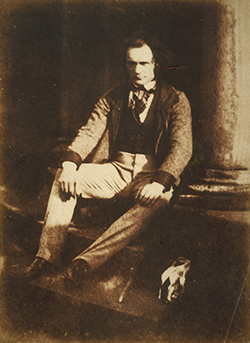 Henry Fox Talbot introduces his patented calotype (or "talbotype") paper negative process, an improved version of his earlier process that greatly reduces the required exposure time.
Henry Fox Talbot introduces his patented calotype (or "talbotype") paper negative process, an improved version of his earlier process that greatly reduces the required exposure time.
In Paris, street lights made from arc lamps are demonstrated.
 Charles Darwin's book The Structure and Distribution of Coral Reefs being the first part of the geology of the voyage of the Beagle, is published. During the year Darwin composes an abstract of his theory of species evolution.
Charles Darwin's book The Structure and Distribution of Coral Reefs being the first part of the geology of the voyage of the Beagle, is published. During the year Darwin composes an abstract of his theory of species evolution.
 Carl Wilhelm von Nägeli (1817-1891) publishes Zur Entwicklungsgeschichte des Pollens. His paper describes cell division in plants with remarkable accuracy, and discusses seed formation in flowering plants.
Carl Wilhelm von Nägeli (1817-1891) publishes Zur Entwicklungsgeschichte des Pollens. His paper describes cell division in plants with remarkable accuracy, and discusses seed formation in flowering plants.
Richard Owen names Cetiosaurus, the sixth named dinosaur species.
 Die Thierchemie, by chemist Baron Justus von Liebig (1803-1873), is published, and the science of biochemistry begins.
Die Thierchemie, by chemist Baron Justus von Liebig (1803-1873), is published, and the science of biochemistry begins.
 The term DINOSAUR is coined by Richard Owen (1804-1892) to describe a class of animals that we now believe were dominant on the Earth for approximately 175 million years.
The term DINOSAUR is coined by Richard Owen (1804-1892) to describe a class of animals that we now believe were dominant on the Earth for approximately 175 million years.
1842
(no entry for this year)
Louis Agassiz completes Les Poissons Fossiles describing fossil fish of the world. This single monograph increases tenfold the formally described vertebrates known to science.
 That the nervous system uses electricity in communicating between different parts of the body is demonstrated by Emil Heinrich du Bois-Reymond (1818-1896). He founds the field of electrophysiology.
That the nervous system uses electricity in communicating between different parts of the body is demonstrated by Emil Heinrich du Bois-Reymond (1818-1896). He founds the field of electrophysiology.
1843
 Jerome Increase Case, a 24 year-old farmer from Oswego County, New York, introduces the J. I. Case Threshing Machine. The J. I. Case Company will manufacture farm equipment and will become the largest thresher producer in the world.
Jerome Increase Case, a 24 year-old farmer from Oswego County, New York, introduces the J. I. Case Threshing Machine. The J. I. Case Company will manufacture farm equipment and will become the largest thresher producer in the world.
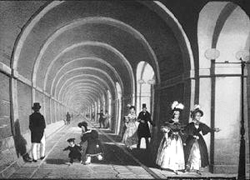 The first tunnel under the Thames opens on March 25, built by Isambard Kingdom Brunel (1806-1859). {a]The Thames Tunnel{/a} connects Rotherhithe and Wapping, London. Although it was a triumph of civil engineering, the Thames Tunnel was not a financial success. It had cost a fortune to build — £454,000 to dig and another £180,000 to fit out — far exceeding its initial cost estimates. Proposals to extend the entrance to accommodate wheeled vehicles failed owing to cost, and it was only used by pedestrians. It became a major tourist attraction, attracting about two million people a year, each paying a penny to pass through.
The first tunnel under the Thames opens on March 25, built by Isambard Kingdom Brunel (1806-1859). {a]The Thames Tunnel{/a} connects Rotherhithe and Wapping, London. Although it was a triumph of civil engineering, the Thames Tunnel was not a financial success. It had cost a fortune to build — £454,000 to dig and another £180,000 to fit out — far exceeding its initial cost estimates. Proposals to extend the entrance to accommodate wheeled vehicles failed owing to cost, and it was only used by pedestrians. It became a major tourist attraction, attracting about two million people a year, each paying a penny to pass through.
 Charles Darwin first outlines his thoughts on natural selection in an unpublished essay.
Charles Darwin first outlines his thoughts on natural selection in an unpublished essay.
 Robert Chambers, a Scottish journalist, publishes (anonymously) his Vestiges of the Natural History of Creation, an early book outlining an evolutionary view of the natural world.
Robert Chambers, a Scottish journalist, publishes (anonymously) his Vestiges of the Natural History of Creation, an early book outlining an evolutionary view of the natural world.
 The second part of the Geology of the Beagle, Charles Darwin's Geological Observations on Volcanic Islands Visited During the Voyage of H.M.S. Beagle, is published. Darwin's book claims to supply evidence for the geological theories of Charles Lyell (1797-1875), from areas that Lyell himself had never seen.
The second part of the Geology of the Beagle, Charles Darwin's Geological Observations on Volcanic Islands Visited During the Voyage of H.M.S. Beagle, is published. Darwin's book claims to supply evidence for the geological theories of Charles Lyell (1797-1875), from areas that Lyell himself had never seen.
 That all the cells in an organism are generated from successive divisions of the egg cell is described by Rudolf Albert von Kölliker (1817-1905). Kölliker shows that the egg is itself a cell.
That all the cells in an organism are generated from successive divisions of the egg cell is described by Rudolf Albert von Kölliker (1817-1905). Kölliker shows that the egg is itself a cell.
1844
 In Hartford, Connecticut, dentist Horace Wells (1815-1848) uses nitrous oxide as an anesthetic; he is the first to do so.
In Hartford, Connecticut, dentist Horace Wells (1815-1848) uses nitrous oxide as an anesthetic; he is the first to do so.
(no entry for this year)
1845
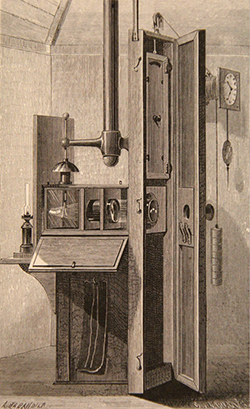 Francis Ronalds invents the first successful camera for continuous recording (the first "movie camera") of the variations in meteorological and geomagnetic parameters over time. A copy of Ronalds' paper describing describing his device maybe obtained HERE.
Francis Ronalds invents the first successful camera for continuous recording (the first "movie camera") of the variations in meteorological and geomagnetic parameters over time. A copy of Ronalds' paper describing describing his device maybe obtained HERE.
 The bridge spanning the Allegheny River, at Pittsburgh, designed by engineer John Augustus Roebling (1806-1869), opens in May. It is the first wire cable suspension aqueduct bridge in the world.
The bridge spanning the Allegheny River, at Pittsburgh, designed by engineer John Augustus Roebling (1806-1869), opens in May. It is the first wire cable suspension aqueduct bridge in the world.
 Karl Wilhelm Von Nägeli shows that plant cells are not formed as buds from the surfaces of existing cells, as was proposed by Theodore Schwann.
Karl Wilhelm Von Nägeli shows that plant cells are not formed as buds from the surfaces of existing cells, as was proposed by Theodore Schwann.
Joseph Leidy identifies in pork the parasite that causes trichinosis, a potentially fatal human disease.
1846
 Nitroglycerine is discovered by chemist Ascanio Sobrero (1811-1870), although he uses to term "pyroglycerine". Because of the risks involved in its production, it will not be manufactured commercially for more than a decade.
Nitroglycerine is discovered by chemist Ascanio Sobrero (1811-1870), although he uses to term "pyroglycerine". Because of the risks involved in its production, it will not be manufactured commercially for more than a decade.
 The lock-stitch sewing machine is patented by Elias Howe (1819-1867).
The lock-stitch sewing machine is patented by Elias Howe (1819-1867).
Jakob Mathias Schleiden and Theodor Schwann announce that cells are the basic units of all living structures.
1847
 The rotary, or "lightning" printing press is patented by Richard March Hoe (1812-1886). It is used first by the Philadelphia Public Ledger.
The rotary, or "lightning" printing press is patented by Richard March Hoe (1812-1886). It is used first by the Philadelphia Public Ledger.
 On the archetype and homologies of the vertebrate skeleton, by Richard Owen (1804-1892), is published. In the book Owen argues that the skull, and other parts of the body, are formed by the modification of the vertebra of different animals.
On the archetype and homologies of the vertebrate skeleton, by Richard Owen (1804-1892), is published. In the book Owen argues that the skull, and other parts of the body, are formed by the modification of the vertebra of different animals.
Richard Owen describes "homologies" — similarities of design in bird wings, fish fins and human hands.
A Neanderthal skull is excavated from Forbes Quarry on the northern side of the Rock of Gibraltar. Over the next few decades, the skull will be stashed in a library cabinet in Gibraltar, dusted off and sent to London, accurately likened to the ancient skullcap from Neander Valley in Germany, nearly named Homo calpicus, and finally stored and largely forgotten in the Royal College of Surgeons.
1848
 Edmond Becquerel makes the first full-color photographs, but they are only laboratory curiosities: an exposure lasting hours or days is required and the colors are so light-sensitive that they sometimes fade right before the viewer's eyes while being examined.
Edmond Becquerel makes the first full-color photographs, but they are only laboratory curiosities: an exposure lasting hours or days is required and the colors are so light-sensitive that they sometimes fade right before the viewer's eyes while being examined.
 Botanist Carl Friedrich von Gärtner (1772-1850) publishes Versuche und Beobachtungen über die Bastarderzeugung im Pflanzenreiche. The book describes thousands of experiments, many involving the production of hybrids, on more than 500 species of plants. Mendel will study this book in detail when he attends the University of Vienna in the early 1850s, and will cite the book in the opening of his paper of 1865.
Botanist Carl Friedrich von Gärtner (1772-1850) publishes Versuche und Beobachtungen über die Bastarderzeugung im Pflanzenreiche. The book describes thousands of experiments, many involving the production of hybrids, on more than 500 species of plants. Mendel will study this book in detail when he attends the University of Vienna in the early 1850s, and will cite the book in the opening of his paper of 1865.
Based on a humerus 58 inches in circumference, Mantell names a new dinosaur species: Pelorosaurus, the first recognized sauropod.
1849
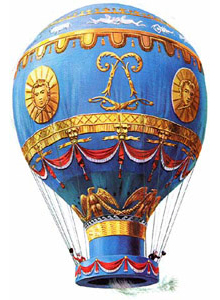 A unmanned Montgolfier balloon is used to drop bombs on Venice. This is the first time a bombing has been conducted from the air.
A unmanned Montgolfier balloon is used to drop bombs on Venice. This is the first time a bombing has been conducted from the air.
ESP Quick Facts
ESP Origins
In the early 1990's, Robert Robbins was a faculty member at Johns Hopkins, where he directed the informatics core of GDB — the human gene-mapping database of the international human genome project. To share papers with colleagues around the world, he set up a small paper-sharing section on his personal web page. This small project evolved into The Electronic Scholarly Publishing Project.
ESP Support
In 1995, Robbins became the VP/IT of the Fred Hutchinson Cancer Research Center in Seattle, WA. Soon after arriving in Seattle, Robbins secured funding, through the ELSI component of the US Human Genome Project, to create the original ESP.ORG web site, with the formal goal of providing free, world-wide access to the literature of classical genetics.
ESP Rationale
Although the methods of molecular biology can seem almost magical to the uninitiated, the original techniques of classical genetics are readily appreciated by one and all: cross individuals that differ in some inherited trait, collect all of the progeny, score their attributes, and propose mechanisms to explain the patterns of inheritance observed.
ESP Goal
In reading the early works of classical genetics, one is drawn, almost inexorably, into ever more complex models, until molecular explanations begin to seem both necessary and natural. At that point, the tools for understanding genome research are at hand. Assisting readers reach this point was the original goal of The Electronic Scholarly Publishing Project.
ESP Usage
Usage of the site grew rapidly and has remained high. Faculty began to use the site for their assigned readings. Other on-line publishers, ranging from The New York Times to Nature referenced ESP materials in their own publications. Nobel laureates (e.g., Joshua Lederberg) regularly used the site and even wrote to suggest changes and improvements.
ESP Content
When the site began, no journals were making their early content available in digital format. As a result, ESP was obliged to digitize classic literature before it could be made available. For many important papers — such as Mendel's original paper or the first genetic map — ESP had to produce entirely new typeset versions of the works, if they were to be available in a high-quality format.
ESP Help
Early support from the DOE component of the Human Genome Project was critically important for getting the ESP project on a firm foundation. Since that funding ended (nearly 20 years ago), the project has been operated as a purely volunteer effort. Anyone wishing to assist in these efforts should send an email to Robbins.
ESP Plans
With the development of methods for adding typeset side notes to PDF files, the ESP project now plans to add annotated versions of some classical papers to its holdings. We also plan to add new reference and pedagogical material. We have already started providing regularly updated, comprehensive bibliographies to the ESP.ORG site.
ESP Picks from Around the Web (updated 06 MAR 2017 )
Old Science

Weird Science

Treating Disease with Fecal Transplantation
Fossils of miniature humans (hobbits) discovered in Indonesia

Dinosaur tail, complete with feathers, found preserved in amber.
Astronomy

Mysterious fast radio burst (FRB) detected in the distant universe.